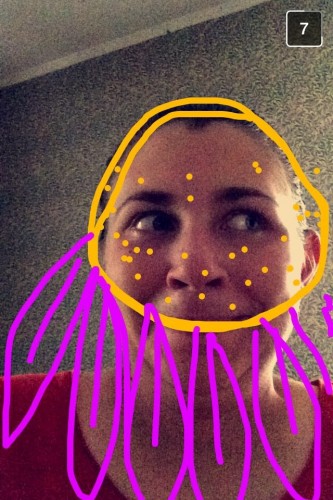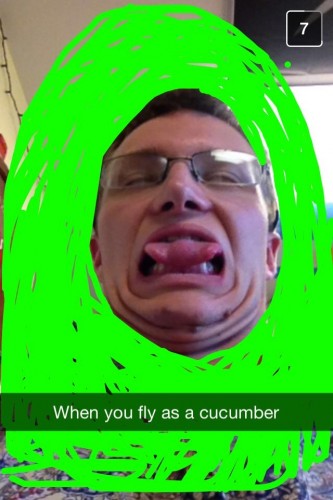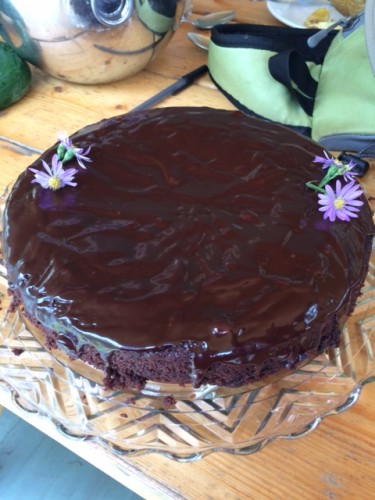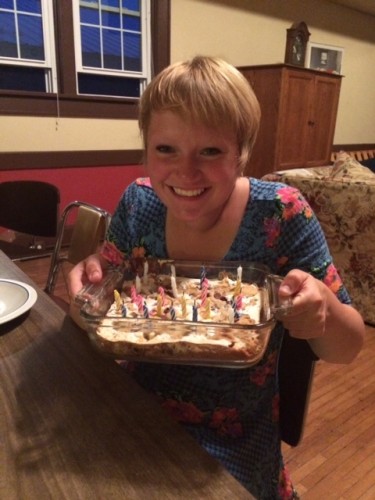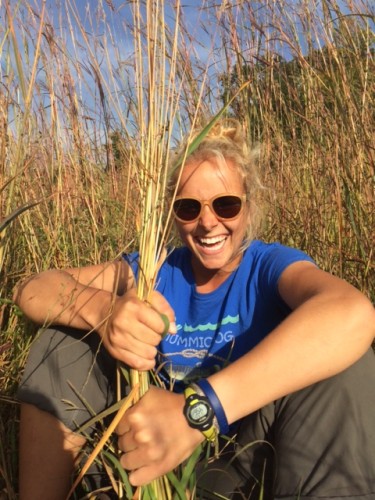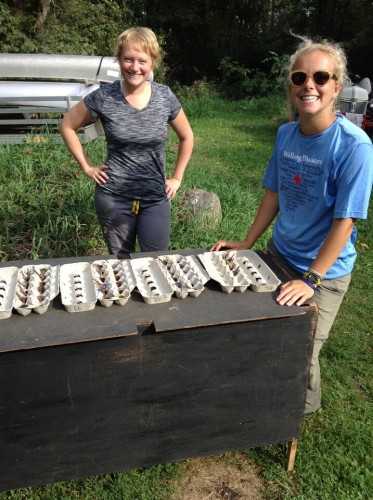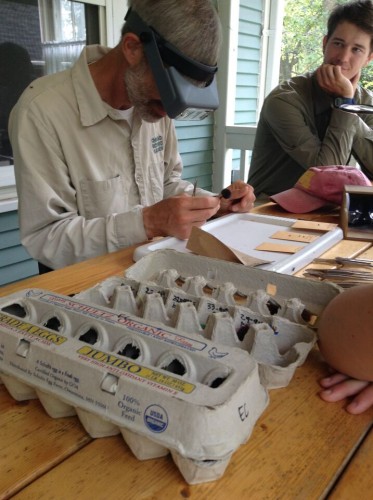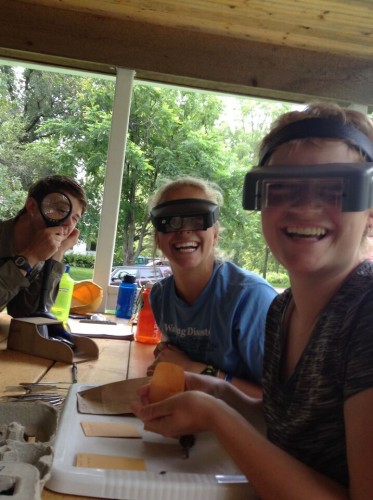|
|
 Pollen vials from sire 403 used in qGen3 The goal of the qGen2 and qGen3 experiments is to compare the evolutionary potential of two remnant prairie populations of Echinacea angustifolia by estimating the additive genetic variance of fitness under two mating scenarios: crosses performed within the core sites (core x core) and crosses performed between the core site and nearby sites (core x periphery). Additionally, we will test for differentiation among families; do progeny from sires differ after accounting for maternal (dam) effects?
In June 2015 we assessed survival and measured 1-year-old plants from qGen2. During the summer and fall of 2015 we replicated the qGen2 experiment through a second crossing experiment. We sowed the resulting achenes in exPt 8 as our qGen3 cohort.
Read more about the qgen2 and qgen3 experiments.
 Dam to be crossed with pollen from 2 sires Start year qGen2: 2013
Start year qGen3: 2015
Location: exPt 1 (dams), remnants Landfill and Staffanson (sires), remnants Landfill (core) & around Landfill (peripheral) and remnants Staffanson (core) & railroad crossing sites (peripheral) (grand-dams), exPt 8 (progeny)
Overlaps with: Heritability of fitness–qGen1
 Keke hard at work counting the q3 offspring Keke is a senior Environmental Studies major at Lake Forest College who has been working in the lab for the past semester. For her project, she focused on the maternal plants of qGen_3. In that experiment, we crossed individuals in p1 with pollen collected from plants at Staffanson and Landfill during the summer and planted the seeds from those crosses in the fall. When dissecting the heads, we only selected achenes that we knew had been crossed properly.
This left ray achenes and achenes that may have been contaminated with other pollen, plus any achenes that we missed! Although we didn’t want to plant inviable or contaminated achenes, knowing the fecundity of the maternal plants is an important part of estimating fitness, so we wanted to have accurate achene counts for each mom. This is where Keke comes in. She removed all of the “extra” achenes and counted them, along with the rest of the maternal achenes which had been scanned in the fall.
Keke also analyzed the effect of a new pollen management procedure that we followed for q3. This procedure involved collecting pollen in multiple vials and taking care to only remove a vial from the refrigerator for crossing once. This was in an effort to reduce exposure of pollen to repeated warming and cooling cycles, which we thought might have reduced its viability in q2. Keke assessed the percent of successful crosses in q2 versus q3 and found that the percent of successful crosses increased 5% with the new procedure. Cool!
You can read more about what Keke did this winter and spring in her report, which can be found here:
Keke’s Q3 Report
Thanks Keke and best of luck in all of your future endeavors!
September 28 started as any ordinary fall day would – in the lab at the Chicago Botanic Garden – but if one were to pay attention they would notice slight change from usual. Our backpacks were more full, the lab tasks were taking lower priority, and both Amy and I had brought a full bag of carrots as snacks. At around noon, Stuart arrived at the Garden after an already long day of traveling, informing us that he and Gretel had just arrived and we would be leaving as soon as possible for Minnesota. After a little more time in the lab, we were off in a white pickup truck with a skybox bearing the crest of the CBG. The journey was long, but uneventful besides a stop in the Twin Cities for ice cream. We arrived in Kensington after 11pm and quickly fell asleep in our former summer residence.
The next 4 days proved to be very productive for the group. We finished measuring at Caroline’s and Lydia’s plot, finished seedling refinds, finished all the “can’t find” rechecks in both P1 and P2, and we removed all the flags from P2. We prepped the burn site by mowing the burn breaks and cutting down branches that were in the path. The weather didn’t cooperate so we weren’t able to burn last week but the forecast was hopeful so we planned to try again Monday, October 5th. Amy stayed up in Kensington with Ali and Katherine and together, the three of them finished dissecting all the heads from Q3. I stayed in Northfield for the weekend, and Stuart and Gretel went back to Illinois.
Monday came and Stuart and I headed back up to the farm with hope in our hearts that we would have a successful burn. We got all the supplies ready, including water packs, buckets, giant containers, and most importantly, drip torches. We started the fire at 3pm, worried about the high humidity and lack of sunlight, but we knew we had to try. After an hour of patchy, inconsistent, slow moving fire, we decided to put out the fire and wait for a better day. Though we weren’t able to burn p8, we were able to create a great burn break and get the team experienced with our fire fighting gear.
On Tuesday, Ali, Katherine, and Amy drove the Ranger down to Illinois, while Stuart and I took the train. It had been a long week filled with many victories and only a single defeat. Though the weather won for a day, we know that we’ll be back and ready to burn once more.
Now that Danny and I are getting settled in at the lab, it’s time to head back to the field! Gretel, Stuart, Danny, and I will be heading out of Chicago on Monday afternoon back to Douglas County for the next week. We spent some time last Friday getting prepared for all of the remaining fieldwork, which includes things like removing flags, re-rechecking demo, and (hopefully!) burning the p8 plot, where the q3 experiment will be planted. We also began making plans for the lab in the coming year–there will be this year’s harvest to process, papers to write, students to mentor, along with improvements we hope to make on the project like a new data entry system to replace the beloved but frail Visors. We talked about who is going to do what and how we’re going to coordinate getting it all done! Rest assured, dear reader, that it will involve to-do lists and technology specially designed to maximize our productivity. Stay tuned as Team Echinacea returns to Minnesota for a busy week of fun and fieldwork!
 See ya Lake Mich
Today and yesterday Katherine and I harvested most of the heads from P1 and P2! It’s an all day affair now that it’s just the two of us, but we enjoyed seeing how much progress we’ve made- many of the rows and all of the heads for Q3 are completely harvested! Today at P2 we had a picnic lunch in the field to maximize efficiency and enjoy the beautiful and clear fall day. I also gained a deeper understanding for just how caring of a person Katherine is. As we were harvesting she carefully ensured no bugs made it into the bag declaring, “Why must I have such a respect for the sanctity of all life!” as she herded another small bug back into its home at hegg. Unfortunately as we headed home, the truck didn’t quite start! Luckily, a kind passerby helped us jump it and after at the auto body shop we got to play with Bo, the friendly and pudgy yellow lab.
We started off today by receiving a post card from Ben! It’s addressed to all of Team Echinacea, so I urge everyone to return to read it in person (and so we can see you)! To say we were overjoyed would be an understatement, and it reminded us how much we miss our buddies who have returned home, to school, and to continue work in Chicago! Unfortunately as you can see from the pictures, some members were not so fortunate as to remain humans after the summer. So much time spent studying Echinacea has caused Gina to turn into an Echinacea and from eating too many cucumbers from the Wagenius’ garden, Ben has become a cucumber! We are impressed by how much this summer influenced our friends both academically, and physically.
 Katherine cuddles Bo while the car is expected!  Gina misses the project so much she’s turned herself into an Echinacea!  We miss Ben, but we like him as a cucumber too
As of Tuesday, 139 out of 153 total Q3 heads have been harvested. That means there are only 14 more to go. Yay!!!
With Gretel having left for Chicago after lunch today, Ali and I are officially alone here in Kensington! While holding down the fort for a week will likely be challenging due to the large amount of fieldwork left to be done, we’re confident that we’ll be able to handle it. Our newfound ability to drive stick-shift has already proved invaluable, and we’re gaining confidence with it every day. This afternoon, we drove around to harvest at the remnants, and we finished off the harvest at Steven’s approach, NW of landfill, and Hegg. Now the truck is parked safely in our driveway, which will be its home for the next month!
Here are some photos from the week!
 The beautiful birthday cake Gretel made me!
 Ali also made me a cake!!  Being hooligans in P1, as usual
This morning we split into 2 groups. Amy and Danny headed over to KJs. They staked points and are now ready for seedling refinds sometime next week. Ali, Katherine and I harvested Q3 heads. We got 40 in all! It sprinkled a little this morning, so the heads were a little damp. We set up a drying station for them.
 Ali and Katherine with the beautiful Q3 heads!
 Lots of colors! After everyone finished up that, Stuart taught Ali and Katherine how to dissect the harvested heads.
 Stuart demonstrates proper dissection methods.  Ali and Katherine practice dissection while Danny does absolutely nothing productive. It sprinkled a little after lunch, so we waited until about 2:00 to head out to P2 to harvest. Although we started a little later than we would have liked, we still finished up in about 2 hours! A lot faster than yesterdays P1 harvest!
To celebrate a week full of hard work and fun, we had root beer floats! Unfortunately, today was my last day with Team Echinacea. I start my senior year at West Central Area High School on Tuesday. I had a great summer and I learned so much! 🙂
Today was one of the first days where the end of summer felt notably, and sadly very near. A big contributer to this feeling was that we finished doing phenology at all of the sites (p1 and p2 included!) before lunch. Several of the sites including East of Town Hall, KJs and North of Golf Course, are finished flowering all together! While Riley’s used to take many hours, it only took me and Will a few minutes to finish up phenology there this morning. At lunch Will taught us a puzzle/riddle which while difficult to explain in a flog post, elicited many laughs and caused hats to be thrown in frustration across the picnic table of the Hjelm house. After lunch, the most of crew went to p1 to continue working on crosses for the Q3 experiment. Many of those are done now too, and we have seen a lot of style shriveling hopefully indicating compatible pollen addition and a successful cross between flowers! Tonight we have a special guest appearance from Erica, Lea’s sister! While we’re all excited that she’s here, it’s bittersweet because it means that Lea is leaving tomorrow morning 🙁 We’re all feeling a little snuffly about Lea’s departure, but excited to stay in touch with all members of the 2015 Echinacea team.
Today started on the porch. We gathered at the table and talked about the tasks at hand. The first order of business involved organizing the mapped GPS data. Maps of all the remnants needed to be checked for missing GPS points and tag errors. Next up was an R Lesson. I loved learning the basics of loading/correcting data and executing a basic statistical test. After the morning lesson, we headed out to do a bit of GPS-ing and phenology at a few remnant sites, then gathered on the porch again for lunch.
After lunch, we started by pulling invasive thistles out of p1. After walking all the rows, we pulled 117 thistles in total! The two most impressive pulls were giant roadside plants seen below.
 Matt’s huge thistle!  Danny’s bouquet
After the thistles were pulled, we moved on to hand crossing heads for Q3. On the way out to cross, I noticed some flowering grasses!
 
Staffanson pollen was organized and put into insulating styrofoam containers that correspond to each data sheet. We worked consistently until all 28 data sheets were complete, and all heads crossed.
 Crossing is almost done!  Stuart passes out pollen.
The days and weeks are starting to fly by as we get into the busy part of the summer. Nearing the end of July, it seems like we’re hovering right around the peak of the flowering season for Echinacea angustifolia. In addition to keeping up with the phenology for our flowers (roughly a couple thousand across our remnants alone!), we’re also making timely progress on independent projects and getting important work done on the q3 experiment.
We got off to a quick start this morning sending half the crew out to do phenology at a handful of sites while Danny and Amy continued their work assessing compatibility across remnant flowers and still a few others collected pollen at Staffanson for q3. While phenology is proving to be quite the time commitment right now, we’re slowly (and satisfyingly) starting to be able to check the “Done flowering” box for more and more of our flowers. The flowering season is tapering off much faster than I had expected!
 A cross-pollinator’s eye view of a well-organized team carrying out crosses in p1. The bright and breezy afternoon had most of the team out in p1 doing pollen crosses for q3. Stuart debuted a new system for keeping us organized in the field as we share, swap, switch, and track down the right vials of sire pollen to be applied to the p1 dams. While the fits of wind that persisted for much of the afternoon were a nice way to cool down, it was not very much appreciated when the breeze swept away the valuable bits of pollen we were trying to apply to our flowers!
The day ended with a visit from some of the parents of the crew members and local science teachers (these two groups actually had quite a bit of overlap). These visits were timed excellently for our guests to appreciate the Echinacea in all their peak flowering glory.
 Bagged and painted Echinacea ready to be cross-pollinated.
|
|






